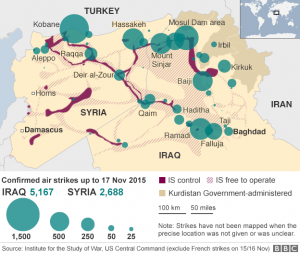Making Sense of the Tangled Alliances fighting ISIS
In theory, more direct intervention by Middle Eastern powers would be the best way to combat the Islamic State (See https://blog.richmond.edu/globalgovernance/2016/02/22/why-less-direct-us-intervention-with-isil-and-more-middle-eastern-intervention-is-key/ ). However, tangled interests and incentives by different countries makes compromise and collective action unrealistic. I’ve tried to come up with quick bullet points to understand the tangled web of characters.

- The Syrian Government led by president Bashar Al-Assad is currently the most effective force fighting the Islamic State, but has committed human rights abuses that have angered the US. The US originally heavily backed anti-Assad opposition, but as the opposition has radicalized, US support may have begun to fade.
- The Kurds in Iraq and Syria have been some of the most effective opponents of the Islamic State, but are hesitant to leave Kurdistan. They receive US backing, but have a tenuous relationship with Iraq and Turkey. The relationship with Iraq is tenuous because they are pushing for independence from Iraq. Furthermore, they have redirected the oil pipeline near Kirkuk. While it used to syphon gas from Kurdistan down to Basra in Iraq for export, they have transferred it North through Turkey. Complicating the relationship, Turkey is currently waging a war against its own Kurds.
- Lebanon does not have the military strength to be much use, but Hezbollah, a Shia group based in Lebanon, has been instrumental in holding Bashar Al-Assad’s southern flank.
- Turkey initially left its borders open to rebels fighting Assad, and supported attempts to take down the Syrian government. Turkey is also bombing Kurds in Turkey.
- The Iraqi government, corrupt and fractured, has not respected the rights of Sunnis post-Saddam Hussein. The politically disenfranchised Sunnis showed little loyalty to the government and many turned quickly to the Islamic state. Sunni cities have been ethnically cleansed by Shia militias, most notably in Tikrit.
- Iran has been one of the biggest backers of the Assad government and the Iranian Revolutionary Guard fights alongside Syrian troops. They have problematically backed Shia militias in Iraq responsible for ethnic cleansing.
- Saudi Arabia has supported the rebels fighting Assad, including some of the more radical groups. Saudi clerics and finding were critical to the early formation of the Islamic State. Saudi Arabia is currently fighting Iran in Yemen, but maintains a historically close relationship with the US.
- The US originally focused its efforts on ousting Assad, but is now bombing and sending special forces against the Islamic States.
- Russia is also bombing the Islamic state. However, Russian special forces and airplanes fight alongside Assad and have targeted moderate rebels alongside the Islamic State.
- Jordan seems to have deigned to become too involved in the fray.
- Israel is unlikely to join forces with all of its traditional enemies to attack a power that is not a direct threat.
An alliance against the Islamic State would require countries to put aside their competing interests. However, many of these interests are very entrenched and take greater priority than defeating the Islamic State. One scenario might be an Assad-Russian assault on the Islamic State in Syria and a US-Iran-Iraq assault on the Islamic state on what is left of Iraq (not Kurdistan). This solution would most likely result in ethnic cleansing and further disenfranchisement of Sunni in the area. Another scenario, straight out of house of cards, might by to promote a coup-d’etat by secular Sunni officers within the Islamic State. Many were former members of Saddam Hussein’s Bath party. A more secular Sunni state in place of the Islamic state might provide the greatest opportunity for Sunni political enfranchisement, but is not likely to be supported by Syria, Iraq, or Iran.